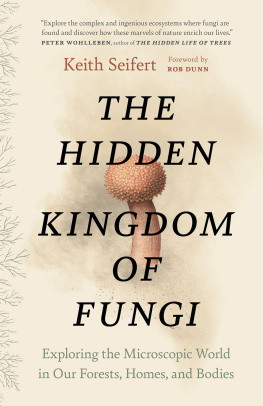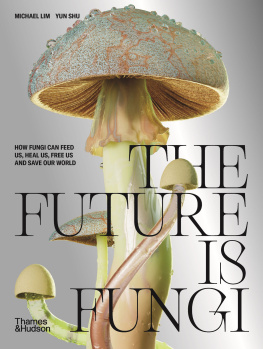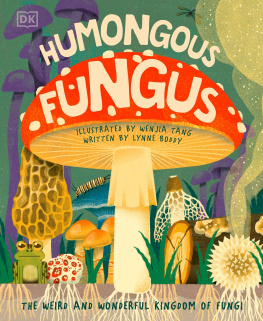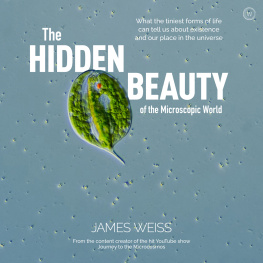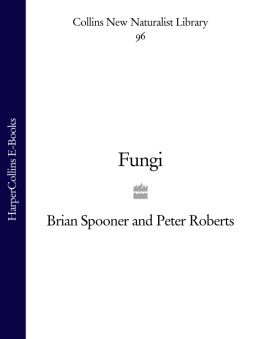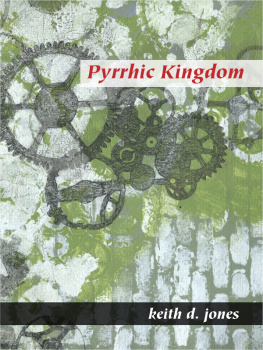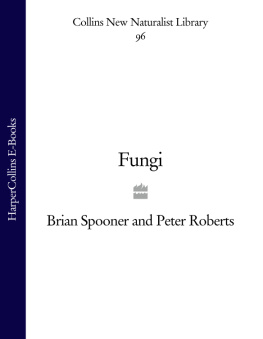Keith Seifert - The Hidden Kingdom of Fungi: Exploring the Microscopic World in Our Forests, Homes, and Bodies
Here you can read online Keith Seifert - The Hidden Kingdom of Fungi: Exploring the Microscopic World in Our Forests, Homes, and Bodies full text of the book (entire story) in english for free. Download pdf and epub, get meaning, cover and reviews about this ebook. year: 2022, publisher: GreyStone, genre: Romance novel. Description of the work, (preface) as well as reviews are available. Best literature library LitArk.com created for fans of good reading and offers a wide selection of genres:
Romance novel
Science fiction
Adventure
Detective
Science
History
Home and family
Prose
Art
Politics
Computer
Non-fiction
Religion
Business
Children
Humor
Choose a favorite category and find really read worthwhile books. Enjoy immersion in the world of imagination, feel the emotions of the characters or learn something new for yourself, make an fascinating discovery.
- Book:The Hidden Kingdom of Fungi: Exploring the Microscopic World in Our Forests, Homes, and Bodies
- Author:
- Publisher:GreyStone
- Genre:
- Year:2022
- Rating:4 / 5
- Favourites:Add to favourites
- Your mark:
- 80
- 1
- 2
- 3
- 4
- 5
The Hidden Kingdom of Fungi: Exploring the Microscopic World in Our Forests, Homes, and Bodies: summary, description and annotation
We offer to read an annotation, description, summary or preface (depends on what the author of the book "The Hidden Kingdom of Fungi: Exploring the Microscopic World in Our Forests, Homes, and Bodies" wrote himself). If you haven't found the necessary information about the book — write in the comments, we will try to find it.
Keith Seifert: author's other books
Who wrote The Hidden Kingdom of Fungi: Exploring the Microscopic World in Our Forests, Homes, and Bodies? Find out the surname, the name of the author of the book and a list of all author's works by series.
The Hidden Kingdom of Fungi: Exploring the Microscopic World in Our Forests, Homes, and Bodies — read online for free the complete book (whole text) full work
Below is the text of the book, divided by pages. System saving the place of the last page read, allows you to conveniently read the book "The Hidden Kingdom of Fungi: Exploring the Microscopic World in Our Forests, Homes, and Bodies" online for free, without having to search again every time where you left off. Put a bookmark, and you can go to the page where you finished reading at any time.
Font size:
Interval:
Bookmark:

Foreword by Rob Dunn
Keith Seifert

FOR THE THREE SISTERS.
We know that we come from the winds, and that we shall return to them; that all life is perhaps a knot, a tangle, a blemish in the eternal smoothness.
E. M. FORSTER
MYCOLOGY IS A DARK ART. Mycologists perceive things that others miss. They traffic in the scarcely visible. They make meaning out of what they see through hand lenses or what they smell when they turn over logs, tip over mushrooms, or sink their hands into the soil. In amongst toadstools, moulds, and yeasts, they find answers to questions but also evidence of mysteries. Augury is the practice of interpreting signs and omens from the behavior of birds. Mycology can be the practice of interpreting the meaning of the world from the behavior of fungi.
The offices of mycologists are rarely new and gleaming. Instead, they tend to be in basements and other forgotten corners of buildings. Like fungi, mycologists often dwell in neglected places. In those places, any extravagances that might be encountered are typically engineered not on behalf of the mycologists themselves, but instead for their quarry, fungi. At my university, for example, air conditioners poke out of broken basement windows where the mycologists work. The air conditioners keep collections of fungi from getting too hot or too wet; the offices of the mycologists, meanwhile, are not nearly so climate controlled.
In their neglected places, mycologists guard a secret. The world, they know, is not as it seems. If you walk outside, you may hear birds singing and you will see plants busily turning light into sugar. The birds and the plants then suggest the rest of lifemice and insects, for example. But this view of life is wrong, entirely wrong. Beneath the world you see and hear, and inside that world, and over and above and around that world, are fungi. Fungi are busy, nearly everywhere (and perhaps everywhere) there is terrestrial life (though also in the sea), carrying out strange slow-motion sexual dances, eating what seems inedible, signaling to one another and to other species too, and then also connecting organisms, one to another. By most accounting, there are more kinds of fungi than there are mammals, birds, and plants combined, perhaps ten times as many. Fungi are the connective tissue of lifenot just that, but certainly that. They hold the living world together. This is what mycologists know. And they see the evidence everywhere they go. It is unavoidable to them, the fungal world of particulars and grandeur. They live in it, they sniff it out, they breathe it in, and, when they get together, they talk about it constantly, using names of species that sound like spells or incantations. Their minds are bubbling flasks of Saccharomyces cerevisiae, Aspergillus, Candida, and Penicillium. And maybe even some Entomophthora muscaespore of flyto boot.
Mostly, the secret world mycologists know, the true world, is secret because it is not obvious and, after years of trying to convince other people to love fungi, mycologists tend to realize it is easier to just talk to other mycologists about what they know and to leave the rest of us out. They retreat to their lairs where they talk about beetles whose brains are taken over by zombie fungi, ants that farm fungi the way that humans grow grain, fungal pathogens that threaten global food supplies, or, just as often, lovely, delicate, poorly known species that they have somewhere seen and just what those species might mean about the broader world.
I have been lucky enough, every so often, to be welcomed by mycologists into their world and, while there, to see things a little more as they are, which is to say to see them a little more fungally. It is a great privilege. Like an astronaut having gone to the moon and then returning to Earth, I return from each visit to the mycologists changed, with a different perspective on everything around me.
It is the extraordinarily good fortune of readers everywhere that Keith Seifert has decided to serve as a guide to the world of fungi, the world as seen by mycologists. In this wonderful book, The Hidden Kingdom of Fungi: Exploring the Microscopic World in Our Forests, Homes, and Bodies, Seifert introduces the reader to that which is obvious to mycologists but hidden to nearly everyone else. His is an insiders tour to, as he puts it, the hidden kingdom.
This book provides snapshots of what are, in essence, the great wonders of the fungal world. There are stories of fungal evolution, tree roots and fungi, plant evolution, beer, agriculture, homes, human bodies, and more. In these stories, one confronts the extraordinary diversity of ways that fungi alter and, really, control the rest of life and even some of non-life. One also finds beautiful details. Seifert has spent his life among the fungi; he knows as much about fungi as any-one knows about anything. Here, though, rather than use his detailed knowledge of the fungal world to catalog each bit of what he knows, Seifert uses that knowledge to heighten the reader s understanding of the big stories; one has the feeling of having been invited as a novice to the mycologists table. The experience is, at once, surprising, thrilling, and engrossing.
And that we are invited is important, because the truth is that mycologists can lead us to see the world as it is (or closer, anyway, to how it is). They can lead us to understand our own place in things. Such an understanding is important, because as Seifert shows in the final chapters of the book, fungi not only control much of the world, they also offer many of the most extraordinary solutions to our future challenges. The fungi have shown the mycologists the way to a great many answers, and Seifert concludes by holding those answers up for the rest of us. Look to the fungi. Learn from their ways.
Its become common to describe our geological epoch as the Anthropocene, the human epoch. The Anthropocene is defined primarily as a function of the extent to which the impact of humanity is clear on the composition of life on Earth and biogeochemical cycles of life and nonlife on Earth. It is true that our impact is great and the naming of our time as the Anthropocene reminds us of that horrible greatness, reminds us of the consequences of each of our days and each of our actions. And yet, from the broader perspective of Seifert and the other mycologists, it is clear that we are not living in the Anthropocene. Instead, we are just in one particularly unusual period of a broader epoch, what one might call the Mycocene. Ours is a fungal world, and by the time I finished this lovely book, I was convinced that however great our human impact might be, it pales in comparison to that of fungi, as it long will.
When humans go extinct, our crops will disappear and so too many of the strange species that depend upon us, from German cockroaches to pigeons. Forests and grasslands will grow back. Populations of medium-sized fish and terrestrial and marine predators will rebound. As our presence is felt, so too will be our absence. But, as Seifert shows through his stories of the fungal world, were fungi to go extinct, the situation would be something else entirely. Wood would cease to decay. Tree roots would be unable to get nutrients. Millions of species would undergo population explosions, their abundances no longer kept in check by their fungal pathogens. The climate would be altered in ways so dramatic as to be difficult to even think about, much less predict. The world is so very deeply and comprehensively fungal that to think about a world without fungi is nearly impossible.
Font size:
Interval:
Bookmark:
Similar books «The Hidden Kingdom of Fungi: Exploring the Microscopic World in Our Forests, Homes, and Bodies»
Look at similar books to The Hidden Kingdom of Fungi: Exploring the Microscopic World in Our Forests, Homes, and Bodies. We have selected literature similar in name and meaning in the hope of providing readers with more options to find new, interesting, not yet read works.
Discussion, reviews of the book The Hidden Kingdom of Fungi: Exploring the Microscopic World in Our Forests, Homes, and Bodies and just readers' own opinions. Leave your comments, write what you think about the work, its meaning or the main characters. Specify what exactly you liked and what you didn't like, and why you think so.

